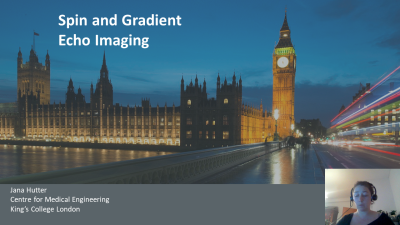Weekday Course
MR Physics for Clinicians: Spins & Sequences
ISMRM & SMRT Annual Meeting • 15-20 May 2021

| Concurrent 7 | 14:00 - 14:30 | Moderators: Patrick Cozzone & Ivan Jambor |
| Spin Gymnastics
Walter Kucharczyk
SYNOPSIS: “SPIN GYMNASTICS” There are two main principles in the MRI process: the basic physics of NMR, and spatial encoding of signal. The basic physics deals with spin, angular momentum, resonance, bulk magnetization, excitation and signal detection. The second describes the application of magnetic field gradients in three dimensions for encoding the location of the signal. 3D animations are used to illustrate complex concepts in a graphically intuitive manner. The overall goal is to provide a working knowledge of the basic physics of MRI in a way that is both intuitive and true to the physics of MRI.
|
||
 |
Basic Pulse Sequences: Gradient & Spin Echo Imaging
Jana Hutter
MRI techniques are often classified into Spin and Gradient echo sequences. This talk will introduce the basic concepts and elements of both sequences, highlight differences in terms of contrast, such as the T2 signal decay in Spin echo sequences and the T2* signal decay in Gradient echo sequences. It will introduce and motivate the concepts of gradient and RF spoiling, balanced sequences and magnetization preparation and finish with a short outlook on accelerating spin and gradient echo sequences using echo trains.
|
|
| Multicontrast Approaches
Stanislas Rapacchi
This presentation presents an overview of multi-contrasts approaches in MRI, from a simple but technical point of view. The presentation starts from two simple examples of multi-contrasts approaches and continues with quantitative multi-contrast approaches. The presentation compares all these approaches in 3 points: 1/ the acquisition schemes that allows to probe multiple contrasts at once, 2/ the underlying model that maps MR signal onto multiple contrasts and allows to disentangle them and 3/ the output contrasts that are eventually provided by the approach of interest. Finally, we will review extensions of multi-contrast approaches with synthetic imaging, segmentation, and standardized reporting.
|
The International Society for Magnetic Resonance in Medicine is accredited by the Accreditation Council for Continuing Medical Education to provide continuing medical education for physicians.